Growing trees in Australia is notoriously difficult but not impossible. In fact, growing the trees themselves is incredibly simple, as they are completely hardy, and happy to grow on most soil types.
The hardest thing about growing cherry trees in Australia is chilling them because they need cold snaps to produce fruit.
In this article, we’re going to explore the best way to plant cherry trees, and how you can trick them into producing fruit, but also, some specially bred varieties that grow delicious fruit without needing a winter chill.
More...
What is a Cherry Tree?
Cherry trees are one of the most iconic Japanese trees, with spring only ever really acknowledged once they have blossomed, and all over Europe, and North America, where the climates mirror Japan, cherry blossom trees (see our complete growing guide on cherry blossom trees here), and fruiting cherry trees have been widely grown for over a century.
As society starts to become more conscious of the air miles behind our food, and the impact of climate change on what we can and can’t grow, it’s fruit like cherries that are become more and more coveted, because to grow any in mass quantities, they need to be shipped in from abroad to reach our shelves.
But it’s possible to grow cherries here in Australia, we just need to adapt slightly to their conditions, and give them what they want – or in some cases, adapt them to work for us.
What is a Cherry Tree’s Natural habitat?
Sweet cherry trees, Prunus avium, are native to Europe and Asia and are part of the same family as wild Plums (hence, Prunus = Prune).
The vast majority of cherry fruit trees are native to the Northern hemisphere where they thrive on the milder climates and more regular rainfall, so to grow any soft fruit in Australia we need to increase watering, and create really good water retention around the base of our trees.
Cherry trees, or at least the wild cherry that is most popularly sold in supermarkets, need pollinating with at least one other cherry tree too, so to get fruit from them, you almost always need a second cherry tree.
Thankfully though, they aren’t fussy about soil. They prefer nutrient-rich moisture-retentive, loamy soils (learn more about loam soils here), but as long as they are watered and properly mulched they will do just fine on chalky ground, sandy soil or clays, provided their plating holes are properly prepared.
Chilling Cherry Trees to Produce More Fruit
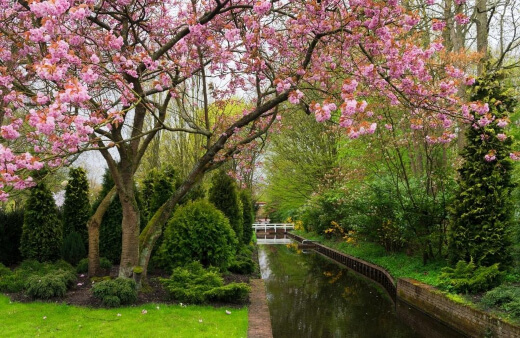
The biggest challenge when growing any cherry fruit tree in Australia is getting them to produce fruit and not just pretty blossom. To get them to fruit in Australia, you need to pick a tree that has been specially bred (which will usually have a weaker flavour) or use some clever trickery.
You’re probably aware of microclimates, but if not, think of them as tiny exceptions to geography, where we can create natural changes in temperatures to the rest of our climate.
By planting against north-facing walls, we create warmer areas of the garden that are great for Mediterranean plants, or by introducing ponds to warm spots we can create more humid spaces. The same is true for cooler temperatures too.
By planting them in an exposed area, with a cool breeze, or on an exposed slope where you know frosts occur more often than other parts of the garden you are much more likely to get fruit from even a European Wild Cherry.


Get Your Free Guide:
Master Growing Australian Natives eBook
A Must Have Complete Guide for Every Australian Garden
Get Your Free Guide:
Master Growing Australian Natives eBook
A Must Have Complete Guide for Every Australian Garden
But just in case, here are some cherry varieties that are more reliable in Australia.
The Best Cherry Trees to Grow in Australia
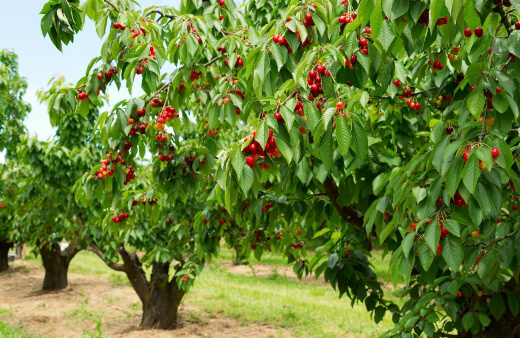
Australia is a wonderful place to grow Mediterranean fruits, and tropical fruits that are comfortable with high heat, and low or irregular rainfall, but for orchard fruits, our climate just doesn’t work.
Over the years, botanists have developed ingenious solutions through selective cultivation which means we have a few truly reliable fruiting cherry trees that grow well in Australia.
These are the five best cherry varieties to grow in Australia:
Trixzie White Cherry Tree
Trixzie White Cherry is a wonderful high-chill dwarf cherry tree that remains compact even when fully mature. Not like some of the 10m tall trees we’re used to seeing in parks covered in clouds of blossom.
While these are miniature trees, they stick pack a wonderful fragrance in spring, and their fruits, though mild, wild almost always set after a mild winter
Minnie Royal Cherry Tree
Minnie Royal is a cherry tree with almost no need for chilling and should work in any part of Australia where the temperatures drop to at least near freezing for a few days.
Their fruits aren’t as sweet as some others, but what they lack in flavour they make up for in visuals. They also take on flavour incredibly well in cooking and have much smaller pits than many other common dwarf cherries, which means you’re getting more cherries per kilo, which is always a bonus.
Royal Lee Cherry Tree
Royal Lee are serious dwarf cherries, usually only growing to around 2m tall at the most, but they are one of the most beautiful fruiting cherries you can grow in Australia. They require very little chilling, so with a cool breeze and some shady winters they should fruit without issue.
The reason I wanted to include Royal Lee though was nothing to do with the fruit though, and much more to do with their wonderful blossom, which is like a blushing cloud and far more similar to the traditional ornamental cherries of Japan than any other variety.
So even if it fails to fruit, it’s worth the space in the garden for the spring display.
Cherry Tree Ruby
Cherry tree ruby is usually supplied as fastigiate trees, but it can sometimes differ depending on their rootstock. They do have a medium chill requirement though, so do need to be kept in cooler parts of the country to fruit effectively.
If you do get them to fruit though, they are one of the sweetest cherries that can be grown in this hemisphere. You’ll never, ever, go back to the cherries from the supermarket if you manage to get a crop of these miraculous crimson fruit trees.
Royal Dawn Cherry Tree
Royal dawn is one of the tallest variety you can grow in Australia that reliably fruit in mild winters. They prefer a cold snap, like any cherry tree, but will produce large dark red fruits that are even sweeter if you let them slightly over-ripen on the tree.
While they are reasonably tall trees, they are still technically dwarf trees, so you shouldn’t try growing them from seed as they need to be grafted onto the appropriate rootstock to control their growth.
Growing Cherry Trees in Australia

Growing Cherry Trees in the Garden
Like all fruit trees, cherry trees like a good root run in rich, well-drained, soil. Unlike Malus and Pyrus trees (apples and pears) which have their main roots close to the surface, cherry trees prefer to grow deep roots through loamy topsoil.
That means that when you plant your tree in the garden you need to dig a hole at least twice the depth of the root ball, and half fill it with a good mix of well-drained, slightly acidic topsoil mixed with rich compost.
The hole should be square, which encourages the roots to grow outwards rather than in spirals around the existing roots.
Choosing the Best Planting Location
This plant prefer a bright sunny spot where their flowers are warmed up to enhance their sweet scent to attract pollinators. But in Australia, we do need to edit that slightly to find the coolest part of the garden, so don’t be afraid to plant a cherry in partial shade away from the worst of the sun’s heat.
How to Grow Cherry Trees in Containers
Dwarf cherry varieties grow well in containers, and many have been developed specifically as patio trees for this purpose. Planting cherry trees in containers is a great way to edit the soil to their preferences, but ensure it has enough water retentive compost in the soil mix so it doesn’t completely dry out in summer.
Soft fruit trees need vast amounts of water in summer to help ripen their fruits, so any container cherry tree should be planted in highly water-retentive compost, and mulched in early spring to prevent surface evaporation as the weather heats up.
How to Propagate Cherry Trees

Propagating from Seed
If you want to plant a cherry tree from seed, it’s actually quite simple, but there are basic warnings before you get too excited:
- Cherry trees grown from supermarket seeds are often from sterile plants, so can germinate, but will not fruit.
- Cherry trees grown from saved seeds are likely to have been pollinated by another tree so may not be true to the parents
- Cherry trees grown from seed may be true to the parent if carefully selected or purchased from seed stores, but the parent is usually only the top half of a grafted tree, so could end up growing to well over 10m tall when mature (unlike the dwarf trees we’re familiar with here).
If you still want to give it a go and want to plant your own from seed, it’s straightforward but the first step might sound a little bit unusual:
- Dry your seeds out on a paper towel for 2-3 days (if saving them from the fruit). When they have dried, place them in an airtight container in the fridge for two months.
This is called Cold stratification, or vernalisation. What you’re doing here is mimicking their natural germination, where cherry pits will lie on the ground, covered in snow for a few weeks in late winter before germinating in spring. - Take your cherry pits out of the fridge, and leave them on the counter until they reach room temperature.
- Fill two small pots with seed compost, and push the seeds just beneath the soil surface.
- Water the seeds and keep the soil moist for the next 3-4 weeks.
- After about a month, the seed should have germinated.
- Now it’s time to pot them on. You can plant them straight into the garden when they reach 2-3ft tall, or continue potting them until their stems are around 1-2” thick (which can take around 3 years)
Grafting Cherry Trees
OK, so I’m not going to try to teach you how to graft here. It’s a massive skill set and requires a lot of work and dedication - plus a selection of ready-grown dwarf cherry trees to root on to, but we can at least cover the basics of how to graft cherry trees to create new trees.
Essentially, grafting fruit trees requires a root and a fruiting tree. A 2 to 3-year-old dwarf cherry tree makes a perfect rootstock, and can be removed from its pot, and cut down to 6” above the soil level. That cut should then be sliced vertically down with a clean sharp knife.
Take a softwood cutting (1-year-old branch) from a mature cherry tree whose fruit you like, and cut the cut end (closest to the trunk) into a point.
You should notice green wood inside the cuts of the rootstock and the top cutting. This is called the cambium (the living part of the tree that will fuse with the other).
Push the top cutting into the slit at the top of the rootstock, and ensure tight contact. Tie them securely together and pour melted wax over the joint to protect them from disease.
There’s more to it than that, but if you want to try it for yourself, it can be a fun experiment.
How to Care for Cherry Trees
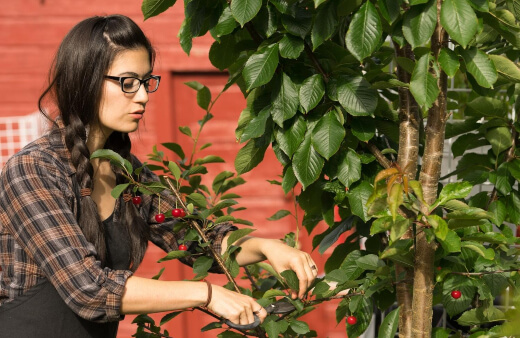
Cherry trees need as much water as you can give them. They are deciduous fruit trees that will turn vivid reds in autumn, and drop all their leaves once they have fruited.
They need this dormant period and use the cold spells to trigger new growth, and fruit-producing blossom the following year.
Knowing how to care for young and old cherry trees alike is fairly straightforward though, and largely about maintaining healthy moisture levels.
Mulching Cherry Trees
Mulching is important for two reasons. They need balanced nutrients rather than powerful fertilisers, and they need as much protection from the sun as possible around their roots.
Mulching mature cherry trees with well-rotted manure is ideal as a mulch, but for younger trees, just general-purpose compost will be fine to add moisture retention without over-stimulating the tree.
Get to know more about the types of mulch and which is best for your plants here.
How to Pollinate Cherry Trees
Cherry trees need a partner tree to pollinate. Some varieties are self-fertile including Stella cherries, Black Gold and North Star cherry trees but, sadly, these trees tend not to grow very well in warm climates, so are unlikely to produce fruit in Australia.
The benefit of planting two dwarf cherries, or two patio cherries near each other is that you can have two slightly different cultivars, so you’ll get fruit at slightly staggered times in summer.
Also, you can encourage better pollination by planting highly fragrant bee-friendly plants near the base of your trees to attract insect pollinators.
Fertilising Cherry Tree
Cherry Trees don’t require fertiliser unless they are ill. A poorly cherry tree with signs of canker or leaf spot can be helped with a low nitrogen feed like traditional Fish, Blood and Bone fertiliser, but the best way to help improve overall plant health is to gently boost the soil acidity with additives like coffee grounds or tea leaves.
Ideally, they need soil between 6.5 and 7 pH which helps them regulate their nutrients.
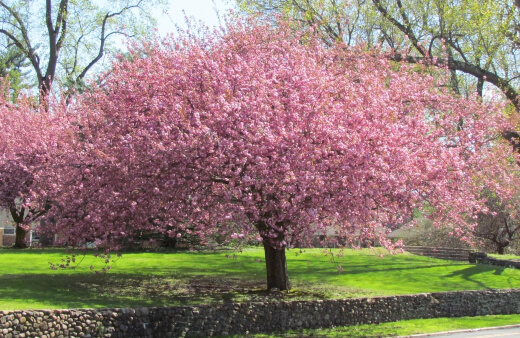
Water Requirements
Cherry trees will usually cope quite well with periods of drought, but should never be allowed to completely dry out at their base, so where possible support them through summer with a bucket of water a week if it’s getting particularly dry.
Otherwise, just make sure they are regularly watered during their fruiting season which helps them develop larger fruits with a fuller flavour.
Cherry Tree Pests and Diseases
Insects
Cherry slug is the soft-skinned larva of the sawfly, and bizarrely, far more common in Australia than in the cherry tree’s native environment.
These larvae feed just like slugs but target Pyrus and Prunus trees, working quickly through young leaves leaving them with skeletal structures before moving on to the net leaf until they grow into flies.
In high enough numbers these pests can completely destroy a cherry tree, preventing it from growing new leaves, and eventually completely failing to photosynthesise, but it would take a huge infestation, and they are best managed with organic controls:
- Method 1: (The easy option) Blast cherry slugs of leaves whenever you see them with a strong jet of water. They can’t survive on dry ground and won’t make it back onto the leaves.
- Method 2: (The stomach-churning option) Cherry slugs are very responsive to their pheromones and when they are harmed they send a signal to others that there is danger on this tree.
By picking off a few slugs, squishing them, and mixing with water, you can create a solution that will put the flies off laying any more eggs on these trees.
Birds
If you’re growing cherries in the hope of a big harvest, be aware that they are an incredibly beneficial food source for pigeons and parrots, and a small flock can eat entire crops in a single afternoon.
What’s even worse (and we’ve watched this happen before) is that the birds will wait for cherries to ripen before they strike, so you can be waiting for the perfect moment to harvest, and be beaten by mere minutes by a flock of pigeons eating your entire crop.
The only way to stop this from happening is by netting the trees or growing them inside a fruit cage.
Bacterial Canker (Pseudomonas syringae)
Bacterial canker can spread from fruit tree to fruit tree, so if you ever notice signs of canker you should act immediately. Canker spreads through touch, so can be spread by tools, human hands, or from birds moving between trees.
If there is any damaged bark on a tree, the bacteria can get into the cuts, and quickly spread through the tree. The first signs of bacterial canker are black scabs on the trunk or branches of a tree.
As soon as you see canker you should cut the affected branch off, then put all the cut materials in airtight bags for disposal, or burn them well away from other fruit trees.
Clean any tools and clothes you were wearing before doing any other gardening. Speaking of clothes, be sure to check our review on the best gardening attires all available online.
Cherry Tree Frequently Asked Questions

Where do cherry trees do best in Australia?
New South Wales, Tasmania and Victoria are the biggest cherry producing states, producing about 4000 tonnes of commercially grown cherries every year in each state.
The trees grown here are largely Van cherries which are reliable fruiters but tend to produce quite small cherries.
Do I need two cherries to get fruit?
If you are planting sweet cherries, then you need two trees to pollinate each other to get fruit. The benefit of this is that you can have two different varieties.
If you prefer the idea of sour cherries though, you can grow a single tree as most varieties of sour cherry are self-pollinating.
How long does it take cherry trees to produce fruit?
If you plant a young cherry tree in the ideal spot, it can take up to four years for it to produce any fruit. They don’t like being moved, so even if you’re planting a mature tree into a new spot, it can take a break from fruiting for a few years before producing cherries again.
Do cherry trees like sun or shade?
Cherry trees should be planted in full sun, and never in the shade of other trees. Ideally, they should have 8 hours of full sun per day. In Australia, this means balancing the sun with increased watering.
Looking for more trees to grow in your garden? Be sure to see our complete guide on growing ornamental pear trees in your garden.
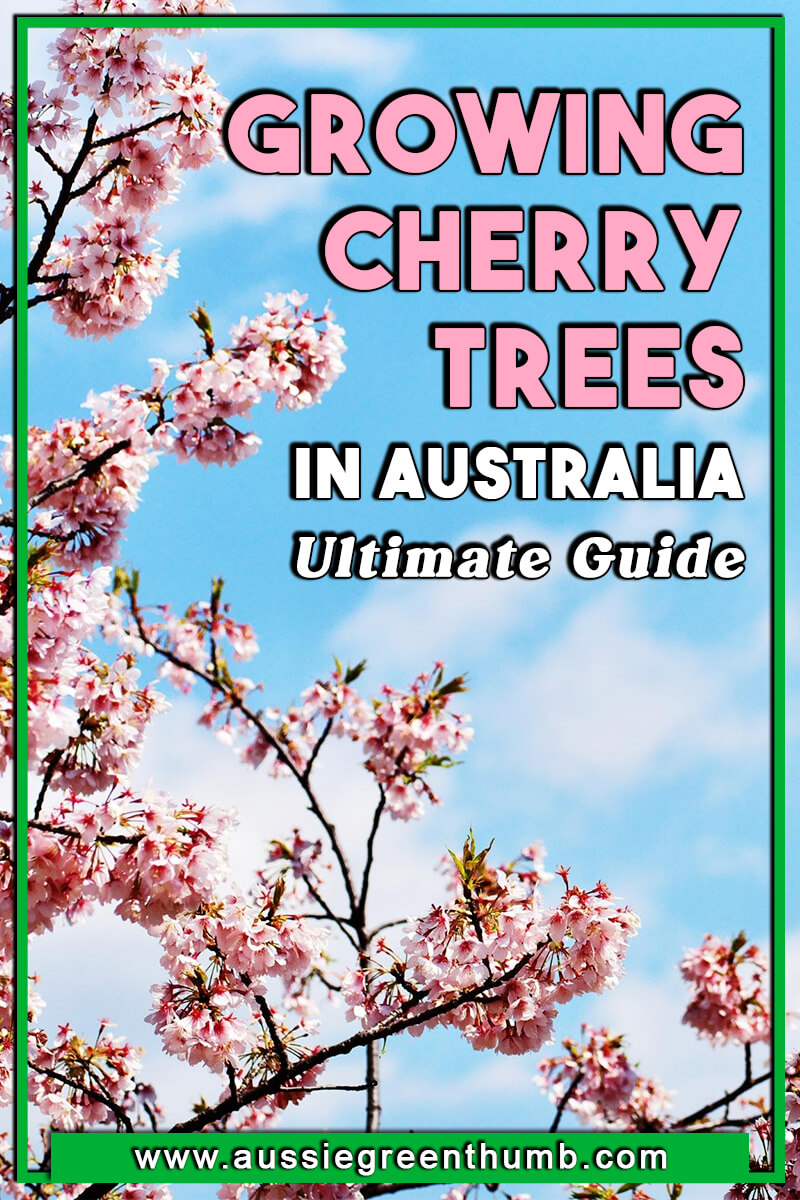
Enhance Your Garden with the Timeless Beauty of Cherry Trees
Cherry trees might be hard to grow, but if you’re unsure of how to get them to fruit, that’s no excuse not to grow them. Even fruiting cherry trees will flower in warm climates, so can be grown as ornamental container cherry trees until you decide how and where to plant them to encourage fruit.
We had our cherry tree in a huge pot for eight years and moved house four times before we found a good spot for it where it would benefit from a winter chill, so don’t rush things.
Growing cherry trees in Australia might not be the easiest task in the world, but it's worth the wait.
Published on February 23, 2022 by Maisie Blevins
Last Updated on February 12, 2024





What is the minimum height for a Cherry Tree …
Hi there Brian,
There are a few varieties of cherry trees available that can offer different growth habits and sizes once matured.
The two common species of cherry trees, namely sweet cherry (Prunus avium) and sour cherry (Prunus cerasus), can both reach 10 metres or more if left unpruned. Generally, in gardens with healthy pruning, they grow to around 5 to 6 metres tall.
If pruned more regularly and potted, you may be able to grow a cherry tree that reaches as little as 3 to 4 metres tall depending on the conditions but fruiting could be diminished.
There are also a few wonderful dwarf cultivars available that usually grow between 1.5 and 2 metres tall. A good example would be the Dwarf Stella Cherry variety which is a prolific bearer of fruits once established and it grows to around 2 to 2.5 metres tall and 2 metres wide.
As with most fruiting trees, size and overall growth habits can sometimes drastically be influenced by your pruning routine and frequency.
If you’re interested in growing the smallest possible cherry tree that will still provide good harvests, I would recommend looking into one of the dwarf cultivars rather than over-pruning the larger growing varieties as this could lead to some unwanted issues down the road since they may not be able to grow to their full potential.
I hope this information helps you. Happy gardening and enjoy your cherry tree!
Gary Clarke
Hi, I have ordered two trees: Minnie Royal and Royal Lee. They will arrive in winter as bare root stock. What distance apart should I plant them? I am thinking of trying to espalier them.
Regards,
Melissa
Hi Melissa,
There are so many styles of espalier, from screening, to wall training, and each had different spacing requirements.
For cherries, they tend to look best when espaliered diagonally, and can be planted at least 1m away from each other (but 2m is better). If you mulch annually with very well-rotted horse manure, or even garden compost, they will get enough nutrients, and retain moisture well around their roots at that sort of spacing.
If you want to grow them as screening, keep them at least 2.5m apart, so they can develop tall standard stems, and then be trained outwards at the top to meet up.
For low growing espaliered cherries (as fencing, or a hedging alternative) plant them about 1.5m apart, which will give them adequate root space, and help them to establish and knit together faster.
Best regards,
Gary Clarke
can you please tell me what to spray my ornamental cherry tree with I have leaf curl and noticed little tiny grubs inside the curled leaves
Hi Judi,
It sounds like webbing caterpillars to me, but if you’ve got a picture that would help with a proper diagnosis. If it’s webbing caterpillars, you can spray it with neem, but I wouldn’t personally advise it.
They’re not going to do any long-term damage, and if the leaves haven’t browned, or spread any visible infection to other parts of the tree, it’s unlikely to cause lasting harm. They’ll usually go away once they’ve become moths or butterflies, and if not, it’s usually just as quick to pick the leaves off and dispose of them one by one.
To prevent it happening again, search for moth traps or moth pheromones online and you can find some great organic-approved deterrents.
Best regards,
Maisie Blevins